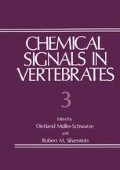Abstract
Kangaroo rats (family Heteromyidae) form a major component of mammalian fauna in the arid deserts of western North America. They have long been considered solitary rodents with a low threshold for the exhibition of agonistic behaviors (Eisenberg, 1963). Although much is known about their ecology, little is known about their social systems and communication. Four years of my research on olfactory communication in the Merriam’s kangaroo rat, Dipodomys merriami indicate that olfactory signals are a major means of communication in this species. Signals originate from at least two sources: sandbathing deposits and urine marks. These odors communicate species and sex, coordinate reproduction, and help to maintain social order.
Access this chapter
Tax calculation will be finalised at checkout
Purchases are for personal use only
Preview
Unable to display preview. Download preview PDF.
References
Aron, C., 1979, Mechanisms of control of the reproductive function by olfactory stimuli in female mammals, Physiol. Rev., 59: 229.
Beatley, J. C., 1969, Dependence of desert rodents on winter annuals and precipitation, Ecology, 50: 721.
Eisenberg, J. F., 1963, The behavior of heteromyid rodents, Univ. California Publ. Zool., 69: 1.
Johnston, R. E., 1979, Olfactory preferences, scent marking, and “proceptivity” in female hamsters, Horm. Behay., 13: 21
Laine, J., and Griswold, J. G., 1976, Sandbathing in kangaroo rats (Dipodomys spectabilis), J. Mammal., 57: 408.
Lepri, J. J., 1981, Hormonal regulation of sandbathing in male kangaroo rats (Dipodomys merriami)., M.S. thesis, Warrensburg. O’Farrell, M. J., 1980, Spatial relationships of rodents in a sagebrush community, J. Mammal., 61: 589.
Randall, J. A., 1981a, Comparison of sandbathing and grooming in two species of kangaroo rat, Anim. Behay., 29: 1213.
Randall, J. A., 1981b, Olfactory communication at sandbathing loci by sympatric species of kangaroo rat, J. Mammal., 62:12. Schmidt-Nielsen, K., 1964, “Desert Animals,” Oxford Univ. Press.
Author information
Authors and Affiliations
Editor information
Editors and Affiliations
Rights and permissions
Copyright information
© 1983 Springer Science+Business Media New York
About this chapter
Cite this chapter
Randall, J.A. (1983). Olfactory Communication in Kangaroo Rats (D. Merriami). In: Müller-Schwarze, D., Silverstein, R.M. (eds) Chemical Signals in Vertebrates 3. Springer, Boston, MA. https://doi.org/10.1007/978-1-4757-9652-0_23
Download citation
DOI: https://doi.org/10.1007/978-1-4757-9652-0_23
Publisher Name: Springer, Boston, MA
Print ISBN: 978-1-4757-9654-4
Online ISBN: 978-1-4757-9652-0
eBook Packages: Springer Book Archive

